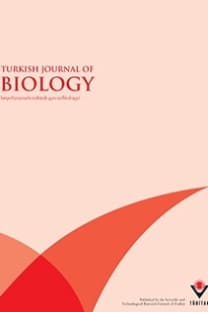Evolutionary Relationship and Divergence Based on SDS-PAGE of Elaeagnus umbellata (Thunb.) Populations, a Multipurpose Plant from the Himalayas
Elaeagnus umbellata, SDS-PAGE, biochemical analysis, evolutionary pattern, Azad Kashmir
Evolutionary Relationship and Divergence Based on SDS-PAGE of Elaeagnus umbellata (Thunb.) Populations, a Multipurpose Plant from the Himalayas
___
- Dirr MA. Manual of Woody Landscape Plants. Their Identification, Ornamental Characteristics, Culture, Propagation and Uses. Stipes, Champaign, Illinois; 1998. 2.
- Sabir SM, Ahmad SD, Lodhi N. Morphological and biochemical
- variation in Sea buckthorn Hippophae rhamnoides L. ssp
- turkestanica, a multipurpose plant for fragile mountains of
- Matthews V. Chemical composition of Elaeagnus umbellata. The New Plantsman. Royal Horticultural Society, pp. 1352-4186.
- Willmoth GC, Foster JG, Hess JL et al. Tocopherol (Vitamin E) content in three invasive, woody species on underutilized farmland. Proceeding Reports of American Forage and grassland Council, 37thNorth American Alfalfa. Improvement Council, Madison, Wisconsin: pp. 86-90, 2000.
- Graham A. The Elaeagnaceae in the Southeastern United States. J. Arnold Arbor. 45: 274-278, 1964.
- Fordham, IM, Clevidence BA, Wiley ER et al. Fruit of autumn- olive; A rich source of lycopene, Hort-Science. Alexandria 36: 1136-1137, 2001.
- Kohlmeier L, Kark JD, Gomez-Garcia E et al. Lycopene and myocardial infarction risk in the EURAMIC study. Amer J Epidemiol 146: 618-626, 1997.
- Giovannnucci E, Ascherio A, Rimm EB et al. Intake of carotenoids and retinol in relation to risk of prostate cancer. J. Natl. Cancer. Inst. 87: 1767-1776, 1997.
- Clinton SK. Lycopene: Chemistry, biology, and implications for human health and disease. Nutr Rev 56: 35-51, 1998.
- Gardiner SE, Ford MB, Slak CR. Grass cultivar identification by sodium dodecylsulphate polyacrylamide gel electrophoresis. New Zealand J Agric Res 29: 193-206, 1986.
- Gardiner SE, Ford MB. SDS polyacrylamide gel electrophoresis of grass seed proteins. A method for cultivar identification of pasture grasses. Seed Sci. Technol 15: 663-674, 1987.
- Aiken SG, Lefkovitch LP. On the separation of two species of Fescue subg. Obtusae Poaceae P. Taxon 42: 323-337, 1993.
- Wilson BL, Liston A. Fine leaved fescues of Oregon; What’s native and what’s not. Report to the Nature Conservancy. Portland, Or. USA, 1995.
- Aiken SG, Gardiner SEG, Bassett HCM et al. 1998. Implications from SDS-PAGE analysis of seed proteins in the classification of taxa of Festuca and Lolium (Poaceae). Biochem System Ecol 26: 511-533, 1998.
- Ahmed SD, Kamal M. Morpho-molecular characterization of local genotypes of Hippophae rhamnoides ssp. Turkestanica, a multipurpose plant from Northern area of Pakistan. Online J Biol Sci 2: 351-354, 2002.
- Ahmad SD, Sabir SM, Lodhi N. Morphological and biochemical comparison of Hippohae rhamnoides, Elaeagnus umbellata and crateagus oxyacantha intra and interspecifically. SA Journal of Botany 71: 231-237, 2005.
- Laemmli UK. Cleavage of structural proteins during the assembly of head bacteriophage T4. Nature 227: 680-685, 1970.
- Sabir SM, Riaz K. Morphological, biochemical and elemental analysis of Elaeagnus umbellata, a multipurpose wild shrub from Pakistan. Appl Hort J 7: 113-116, 2005.
- ISSN: 1300-0152
- Yayın Aralığı: 6
- Yayıncı: TÜBİTAK
Dilnawaz Syed AHMAD, Mubashar Syed SABİR, Halimi MOHAMMED, Yousaf SALİHUDDİN
Plant growth promoting properties of rhizobacteria isolated from wheat and pea greown in sand soil
Effects of Drought Stress on Soluble Proteins in two Maize Varieties
Nayer MOHAMMADKHANI, Reza HEIDARI
Antioxidant Activity of Some Common Plants
Nooman A. KHALAF, Ashok K. SHAKYA, Atif AL-OTHMAN, Zaha EL-AGBAR, Husni FARAH
V. Sumitra CHANDA, Jigna PAREKH
Mohd. Musheer ALTAF, Farhana MASOOD, Abdul MALIK
Effect of Modes of Application of 28-Homobrassinolide on Mung Bean
Qazi FARIDUDDIN, Syed Aiman HASAN, Barket ALI, Shamsul HAYAT, Aqil AHMAD
Firas A. AL-BAYATI, Khudir D. SULAIMAN
Syed Dilnawaz AHMAD, Syed Mubashar SABIR, Halimi Mohammed SAUD, Yousaf SALIHUDDIN
